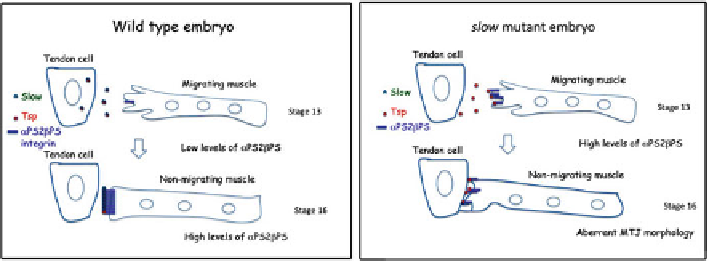Biomedical Engineering Reference
In-Depth Information
Fig. 6.5
Gradual construction of the MRJ is mediated by Slow activity.
Left panel
—in wild type
embryo, Slow and Tsp are secreted from the tendon cell and form a protein complex that inhibits
Tsp binding to the muscle integrin receptors prematurely. Only following the arrest of muscle
migration, Tsp binds to the integrin receptors, promoting their high accumulation at the muscle
ends and a proper formation of MTJ.
Right panel
—in
slow
mutant embryos, integrin receptors
accumulate at the leading edge of the muscle prior to the arrest of muscle migration. This leads to
aberrant construction of the MTJ that eventually leads to muscle or tendon tearing during larvae
movements
Recently, a secreted tendon-specific protein, Slowdown (Slow), was shown to
modulate the responsiveness of the muscle integrins to Tsp, presumably through its
Tsp association [
17
]. Lack of
slow
leads to a severe locomotion phenotype in
homozygous larvae, and an inability to fly in adult
slow
homozygous mutant
escapers. In
slow
mutants, a premature association between Tsp and the muscle
a
PS integrin was demonstrated, leading to the accumulation of integrin
receptors on the muscle ends prior to the muscle's arrival at the tendon cell. This
leads to asymmetric force distribution between muscles and tendons, causing mus-
cle, as well as tendon tearing (Fig.
6.5
). Thus, when the interface of the MTJ has not
been constructed in a correct manner, both the tendon and the muscle are exposed to
aberrant distribution of the mechanical load developed by muscle contraction. This
leads to occasional tearing of muscles or tendons, and muscle dysfunction.
Interestingly, a similar phenotype is also obtained when muscle integrin
receptors are overexpressed in the muscle cells [
33
]. Premature “spotty” junctions
are detected, and an aberrant MTJ is formed between the muscle and its tendon cell.
Therefore, the gradual construction of the MTJ as well as the correct assembly of
the ECM is critical for proper musculoskeletal function.
PS2
b
6.5 Arrest of Muscle Migration
The arrival of the muscle cell at the target tendon cell and the formation of the MTJ
are temporally and spatially coupled. However, it is not clear how tendon recogni-
tion, arrest of muscle migration, and initiation of MTJ formation are coordinated at
the molecular level. The transmembrane protein kon-tiki/perdido was shown to

Search WWH ::

Custom Search